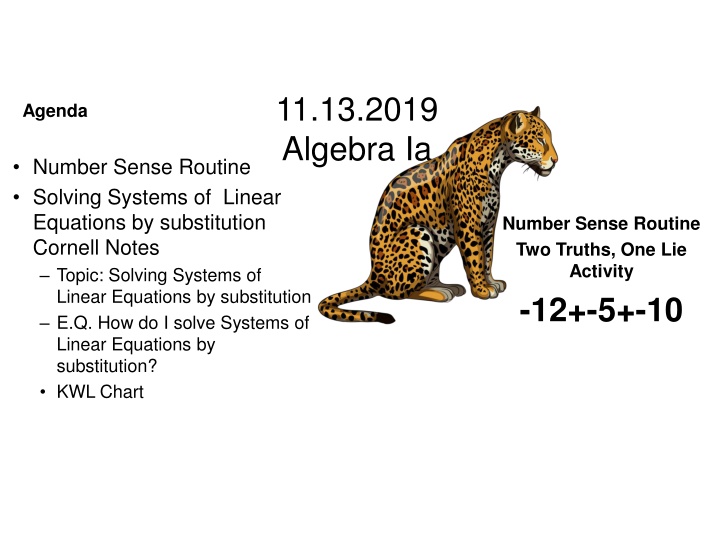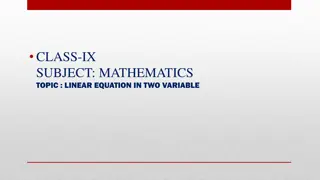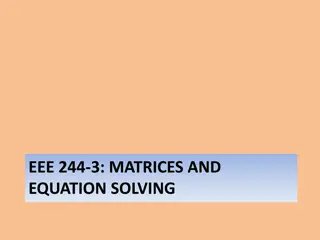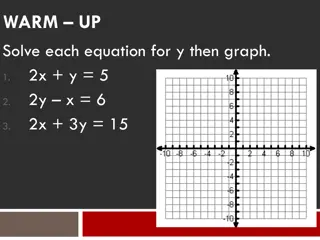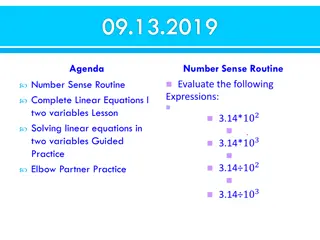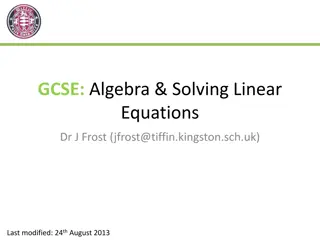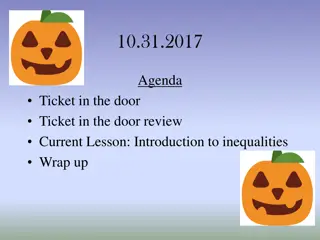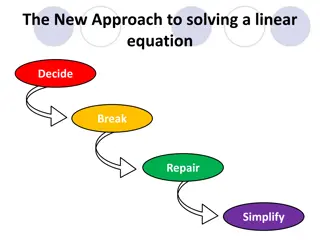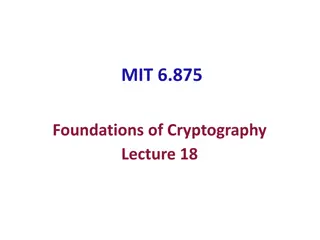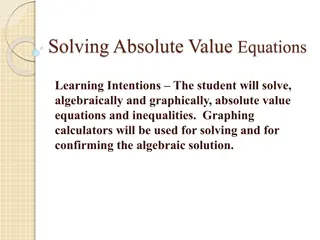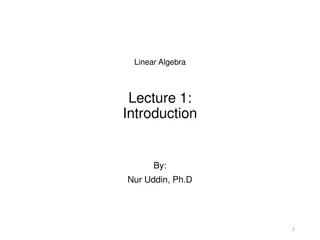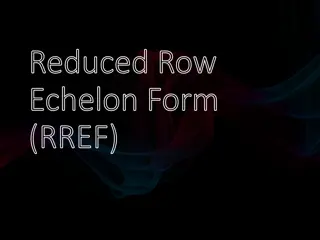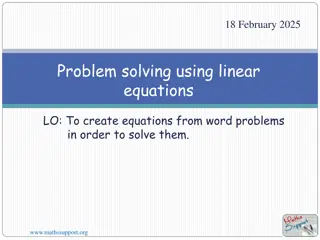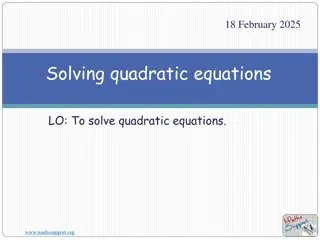Reasoning with Equations & Inequalities: Solving Linear Expressions
Explore linear equations and inequalities, creating and solving them in one variable with coefficients represented by letters. Dive into real-world applications, essential questions, vocabulary, and capabilities students should achieve by the end of the unit. Experience a comprehensive learning journey with a focus on justifying solutions and graphically solving systems.
Download Presentation

Please find below an Image/Link to download the presentation.
The content on the website is provided AS IS for your information and personal use only. It may not be sold, licensed, or shared on other websites without obtaining consent from the author.If you encounter any issues during the download, it is possible that the publisher has removed the file from their server.
You are allowed to download the files provided on this website for personal or commercial use, subject to the condition that they are used lawfully. All files are the property of their respective owners.
The content on the website is provided AS IS for your information and personal use only. It may not be sold, licensed, or shared on other websites without obtaining consent from the author.
E N D
Presentation Transcript
11.13.2019 Algebra Ia Agenda Number Sense Routine Solving Systems of Linear Equations by substitution Cornell Notes Topic: Solving Systems of Linear Equations by substitution E.Q. How do I solve Systems of Linear Equations by substitution? KWL Chart Number Sense Routine Two Truths, One Lie Activity -12+-5+-10
Objective The student will be able to: solve systems of equations using substitution. SOL: A.4e Designed by Skip Tyler, Varina High School
Solving Systems of Equations You can solve a system of equations using different methods. The idea is to determine which method is easiest for that particular problem. These notes show how to solve the system algebraically using SUBSTITUTION.
Solving a system of equations by substitution Pick the easier equation. The goal is to get y= ; x= ; a= ; etc. Step 1: Solve an equation for one variable. Put the equation solved in Step 1 into the other equation. Step 2: Substitute Get the variable by itself. Step 3: Solve the equation. Substitute the value of the variable into the equation. Step 4: Plug back in to find the other variable. Substitute your ordered pair into BOTH equations. Step 5: Check your solution.
1) Solve the system using substitution x + y = 5 y = 3 + x The second equation is already solved for y! Step 1: Solve an equation for one variable. x + y = 5 x + (3 + x) = 5 Step 2: Substitute 2x + 3 = 5 2x = 2 x = 1 Step 3: Solve the equation.
1) Solve the system using substitution x + y = 5 y = 3 + x x + y = 5 (1) + y = 5 y = 4 (1, 4) (1) + (4) = 5 (4) = 3 + (1) Step 4: Plug back in to find the other variable. Step 5: Check your solution. The solution is (1, 4). What do you think the answer would be if you graphed the two equations?
Which answer checks correctly? 3x y = 4 x = 4y - 17 (2, 2) (5, 3) (3, 5) (3, -5) 1. 2. 3. 4.
2) Solve the system using substitution 3y + x = 7 4x 2y = 0 It is easiest to solve the first equation for x. 3y + x = 7 -3y -3y x = -3y + 7 4x 2y = 0 4(-3y + 7) 2y = 0 Step 1: Solve an equation for one variable. Step 2: Substitute
2) Solve the system using substitution 3y + x = 7 4x 2y = 0 -12y + 28 2y = 0 -14y + 28 = 0 -14y = -28 y = 2 Step 3: Solve the equation. 4x 2y = 0 4x 2(2) = 0 4x 4 = 0 4x = 4 x = 1 Step 4: Plug back in to find the other variable.
2) Solve the system using substitution 3y + x = 7 4x 2y = 0 (1, 2) Step 5: Check your solution. 3(2) + (1) = 7 4(1) 2(2) = 0 When is solving systems by substitution easier to do than graphing? When only one of the equations has a variable already isolated (like in example #1).
If you solved the first equation for x, what would be substituted into the bottom equation. 2x + 4y = 4 3x + 2y = 22 1. -4y + 4 2. -2y + 2 3. -2x + 4 4. -2y+ 22
3) Solve the system using substitution x = 3 y x + y = 7 The first equation is already solved for x! x + y = 7 (3 y) + y = 7 3 = 7 The variables were eliminated!! This is a special case. Does 3 = 7? FALSE! Step 1: Solve an equation for one variable. Step 2: Substitute Step 3: Solve the equation. When the result is FALSE, the answer is NO SOLUTIONS.
3) Solve the system using substitution 2x + y = 4 4x + 2y = 8 The first equation is easiest to solved for y! y = -2x + 4 4x + 2y = 8 4x + 2(-2x + 4) = 8 4x 4x + 8 = 8 8 = 8 This is also a special case. Does 8 = 8? TRUE! Step 1: Solve an equation for one variable. Step 2: Substitute Step 3: Solve the equation. When the result is TRUE, the answer is INFINITELY MANY SOLUTIONS.
What does it mean if the result is TRUE? The lines intersect The lines are parallel The lines are coinciding The lines reciprocate I can spell my name 1. 2. 3. 4. 5.
Closing KWL Chart
Reference teachers.henrico.k12.va.us math documents SolveSystemsBySub
